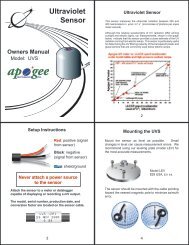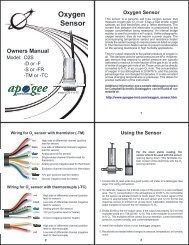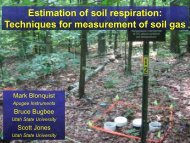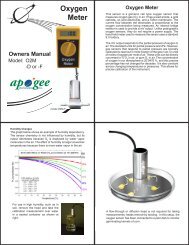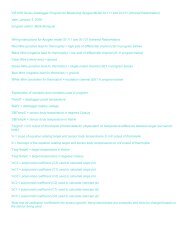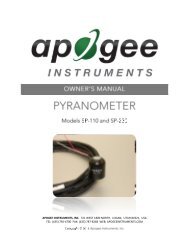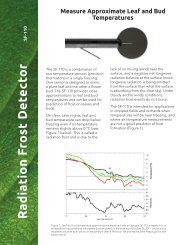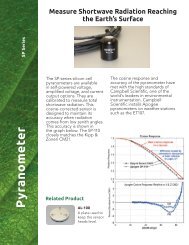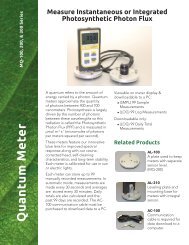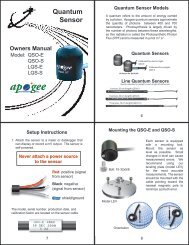Infrared Radiometer - Apogee Instruments
Infrared Radiometer - Apogee Instruments
Infrared Radiometer - Apogee Instruments
You also want an ePaper? Increase the reach of your titles
YUMPU automatically turns print PDFs into web optimized ePapers that Google loves.
<strong>Infrared</strong> <strong>Radiometer</strong><br />
SI-200 & 300 Series
<strong>Infrared</strong> <strong>Radiometer</strong><br />
Accurate measurement of the leaf-to-air temperature gradient is<br />
important for irrigation scheduling and the determination of energy<br />
transfer, transpiration rate, and stomatal conductance in both single<br />
leaves and plant canopies. This gradient is often less than 1 C, which<br />
means the leaf temperature should be measured to within 0.1 C. To<br />
achieve this accuracy, we measure and correct for changes in the<br />
sensor body temperature.<br />
Application<br />
Measurement of surface temperature is a crucial component of energy<br />
transfer. Accurate measurement of the leaf-to-air temperature gradient<br />
is essential to the determination of transpiration rate and stomatal<br />
conductance in both single leaves and plant canopies.<br />
Wiring Diagram<br />
Target<br />
Yellow wire = high<br />
Red wire = low<br />
Sensor Body<br />
Yellow wire = high<br />
Red wire = low<br />
Bare wire = analog ground<br />
High<br />
Low<br />
Analog ground<br />
High<br />
Low<br />
Sample programming instructions are included with shipment and can<br />
also be downloaded from our website at:<br />
apogeeinstruments.com/infrared_temperature_sensors.htm<br />
2
Atmospheric Transmission<br />
The infrared radiometer window is reported as 6.5 to 14 µm. Although<br />
the cut off at 14 µm is not sharp, radiation at those wavelengths is<br />
minimum.<br />
Cleaning<br />
Debris on the radiometer is a common cause of low readings. Salt<br />
deposits can accumulate on a sensor from evaporation of sprinkler<br />
irrigation water and dust, which can accumulate during periods of low<br />
rainfall. Salt deposits should be dissolved and removed with vinegar<br />
and a soft cloth or q-tip. Dust and other organic deposits are best<br />
removed with water, rubbing alcohol, or window cleaner. Never use<br />
an abrasive cleaner on the window.<br />
3
Correction for Sensor Body<br />
Temperature<br />
The output of infrared sensors is determined by the difference<br />
between the target temperature and the temperature of the infrared<br />
detector (the reference temperature). Consequently, an error in the<br />
measurement of the detector reference temperature results in an error<br />
in the measurement of the target temperature. The device used to<br />
measure the detector temperature is not usually in perfect equilibrium<br />
with the detector so reference temperature errors are particularly<br />
large when the sensor body temperature fluctuates. This error is<br />
minimized by adding thermal mass around the detector to prevent<br />
rapid temperature changes and to keep all parts of the sensor at the<br />
same temperature. Published calibration procedures often describe<br />
detailed procedures to determine the temperature and emissivity of<br />
the black body calibration target but neglect the effect of sensor body<br />
temperature.<br />
4
Field of View<br />
The field of view (FOV) is reported as the half-angle of the apex of the<br />
cone formed by the target (cone base) and the detector (cone apex).<br />
The target is a circle form which 98% of the radiation viewed by the<br />
detector is being emitted.<br />
Model SI-211<br />
Half Angle = 28°<br />
6
Specifications<br />
Output<br />
• 2 type K thermocouple wires<br />
Accuracy<br />
• SI-211 & SI-212: ± 0.5 C<br />
• SI-311 & SI-312: ± 0.2 C<br />
Optics<br />
• Silicon lens<br />
Wavelength Range<br />
• 6.5 - 14 µm<br />
Field of View (FOV)<br />
• 28° half angle<br />
Response Time<br />
• Less than 1 second to<br />
changes in target temperature<br />
Input Power<br />
• None<br />
Datalogger Channels<br />
• Two differential<br />
Operating Environment<br />
• -40 to 60 C<br />
• Calibrated range: -15 to 60 C<br />
• Highly water resistant<br />
• Designed for continuous<br />
outdoor use<br />
Cable<br />
• 5 meters of twisted, shielded<br />
4-thermocouple wire with<br />
casing<br />
• Ending in pigtail leads<br />
• Additional cable is available in<br />
multiples of 5 meters<br />
Dimensions<br />
• 6.0 cm long<br />
• 2.3 cm diameter<br />
Warranty<br />
• 1 year against defects in<br />
materials and workmanship<br />
7
www.apogeeinstruments.com<br />
techsupport@apogeeinstruments.com<br />
435.792.4700<br />
Fax: 435.787.8268



